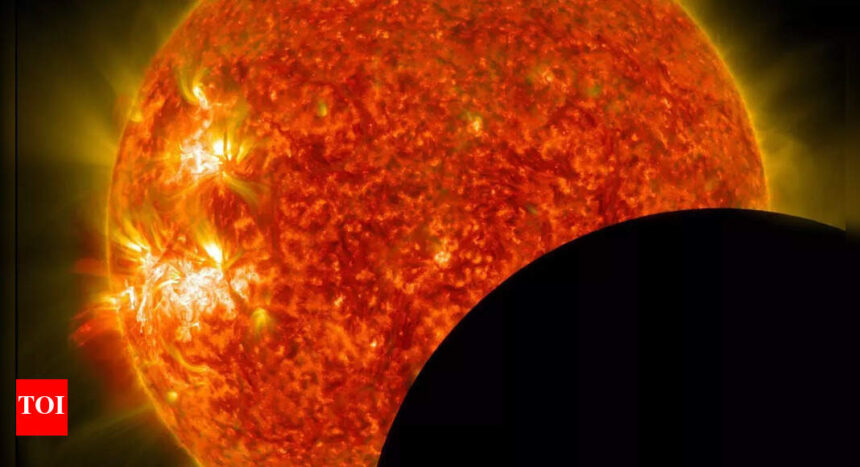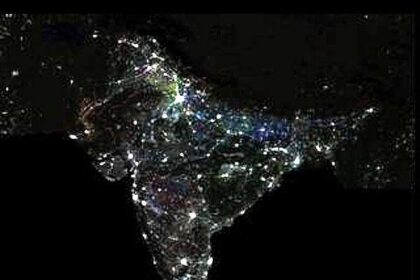Celestial Events: A Fascination for Scientists and Astronomers
Celestial events have captivated scientists and astronomers for centuries, providing valuable insights into the solar system’s operation. One of the most dramatic events is a solar eclipse, a brief period when the moon passes between the Earth and the sun, partially or fully blocking the sun’s light. While some eclipses can be seen from Earth, others can only be observed from space.
Thanks to advanced satellites like NASA’s Solar Dynamics Observatory (SDO), which continuously monitors the sun in high definition, these otherwise invisible phenomena are captured in stunning detail. These observations enhance our understanding of solar activity and its interactions with nearby stars.
NASA’s SDO Captures Rare Solar Eclipse Visible Only from Space
On April 27th, a rare astral event occurred that could not be seen from Earth. It was a partial solar eclipse where the moon intercepted between the Earth and the sun, blocking about 23% of the sun’s face. The eclipse itself was only observable from space. Fortunately, NASA’s SDO, a satellite orbiting Earth that constantly watches the sun, captured images of the event, a "lunar transit."
The SDO, launched in 2010, has tools that can view the sun in high definition. It took stunning, unbroken photographs of the event, a "lunar transit." In this kind of eclipse, the moon appears as a dark, giant sphere creeping across the sun’s radiating face. Since Earth-bound observers had no idea that this space event was occurring, the spaceborne location of the SDO allowed it to film the eclipse from beginning to end, providing researchers with valuable information and a glimpse at an event impossible on the surface.
What is the Solar Dynamics Observatory?
The Solar Dynamics Observatory (SDO) is a standalone satellite responsible for monitoring the sun around the clock. Launched by NASA in February 2010, SDO orbits the Earth and is positioned in front of the sun to provide never-before-seen information on solar activity. Its ability to capture high-definition photos has made it an important tool in tracking solar events, including lunar transits, eclipses, and solar flares. During its working lifetime, the spacecraft observed numerous eclipses, several of which human observers on Earth were not able to witness.
NASA Eyes More Eclipses as SDO Builds on Historic Observations
NASA has already forecasted two more eclipses to take place in the next few months. The first will be on May 25, with the moon covering only 4% of the sun. The second will be a darker eclipse on July 25, with the moon covering 62% of the sun. Both these upcoming eclipses will likely be seen and photographed by the Solar Dynamics Observatory, increasing our understanding of the sun and how it acts compared to the moon.
Historical Background of Solar Eclipses from Space
It is not the first instance where eclipses were witnessed beyond the atmosphere. During the Apollo missions, astronauts during moon missions were fortunate enough to experience solar eclipses in their initial flights. Such observations are still of gargantuan significance in space history and solar phenomenon research.
From Blood Moons to Solar Eclipses: What’s Next in the Sky?
Apart from the partial solar eclipse picture captured by SDO, NASA has even witnessed lunar eclipses such as this year’s Blood Moon. A lunar eclipse occurs when the moon, Earth, and sun are in line with Earth casting a shadow upon the moon. The moon moves completely into the inner shadow of Earth, or umbra, during a total lunar eclipse. The moon turns dark red, and it is this that creates the appearance that we know as a "Blood Moon."
In the distance are some eclipses worth looking at. Next in line are a set of some eclipses worth watching. The next solar eclipse to watch on Earth is Sept. 21 and observable from Antarctica, South Pacific, and New Zealand. Perhaps the most highly expected one, however, is the Aug. 12, 2026 total solar eclipse. It is visible only once in a year and is visible only on a thin path of totality that goes through eastern Greenland, western Iceland, and northern Spain. The moon completely covers the path of the sun in a total eclipse, presenting the observers with a view of the corona of the sun—a view that is witnessed only except for a total eclipse.
Also Read:
Reference : https://timesofindia.indiatimes.com/science/nasas-space-observatory-captures-a-rare-solar-eclipse-visible-only-from-space-revealing-an-unseen-celestial-phenomenon/articleshow/120727715.cms








